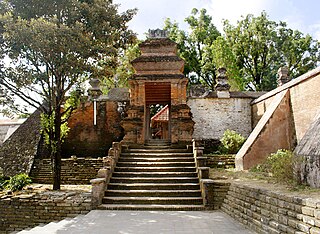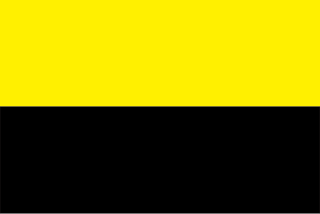
The Sultanate of Mataram was the last major independent Javanese kingdom on the island of Java before it was colonised by the Dutch. It was the dominant political force radiating from the interior of Central Java from the late 16th century until the beginning of the 18th century.

Kraton or keraton is a type of royal palace in Java, Indonesia. Its name is derived from the Javanese ka-ratu-an, meaning residence of the ratu, the traditional honorific title for a monarch. In Java, the palace of a prince is called pura or dalem, while the general word for palace is istana, identical to Malay.

Sultan Anyakrakusuma is known as Sultan Agung was the third Sultan of Mataram in Central Java ruling from 1613 to 1645. He was a skilled soldier who conquered neighbouring states and expanded and consolidated his kingdom to its greatest territorial and military power.

Kotagede is a city district (kemantren) and a historic neighborhood in Yogyakarta, Special Region of Yogyakarta, Indonesia. Kotagede contains the remains of the first capital of Mataram Sultanate, established in the 16th century. Some of the remains of the old Kotagede are remains of the palace, the royal cemetery, the royal mosque, and defensive walls and moats. Kotagede is well known internationally by its silver crafting.

The Kingdom of Pajang or Sultanate of Pajang was a short-lived Muslim state in Java. It was established by Hadiwijaya or Jaka Tingkir, Lord of Boyolali, after a civil war and was a successor to Sultanate of Demak. Hadiwijaya claimed to be a descendant of Brawijaya V, the last king of the Majapahit empire, and Trenggana, the sultan of Demak.
Kyai Gedhe Pamanahan was the first ruler of the Sultanate of Mataram. He is also referred to as Kyai Gedhe Mataram.

Amangkurat II was the susuhunan of the Sultanate of Mataram from 1677 to 1703. Prior to taking the throne, he was the crown prince and had the title Pangeran Adipati Anom.

The Banten Sultanate was a Bantenese Islamic trading kingdom founded in the 16th century and centred in Banten, a port city on the northwest coast of Java; the contemporary English name of both was Bantam. It is said to have been founded by Sunan Gunungjati, who had previously founded Cirebon.

The Demak Sultanate was a Javanese Muslim state located on Java's north coast in Indonesia, at the site of the present-day city of Demak. A port fief to the Hindu-Buddhist Majapahit kingdom thought to have been founded in the last quarter of the 15th century, it was influenced by Islam brought by Muslim traders from China, Gujarat, Arabia and also Islamic kingdoms in the region, such as Samudra Pasai, Malacca and Bani (Muslim) Champa. The sultanate was the first Muslim state in Java, and once dominated most of the northern coast of Java and southern Sumatra.

The Sultanate of Cirebon was an Islamic sultanate in West Java founded in the 15th century. It is said to have been founded by Sunan Gunungjati, as marked by his letter proclaiming Cirebon's independence from Pajajaran in 1482, although the settlement and the polity had been established earlier, in 1445. Sunan Gunungjati also established the Sultanate of Banten. It was one of the earliest Islamic states established in Java, along with the Sultanate of Demak.
Joko Tingkir, or sometimes written as Jaka Tingkir, is the founder and the first king of the Sultanate of Pajang. He ruled from 1549 to 1582. He is also known by the title of Sultan Hadiwijaya.

Sultanate of Banjar or Sultanate of Banjarmasin was a sultanate located in what is today the South Kalimantan province of Indonesia. For most of its history, its capital was at Banjarmasin.

Surakarta Sunanate is a Javanese monarchy centred in the city of Surakarta, in the province of Central Java, Indonesia.

Kalinyamat Sultanate or Kalinyamat Kingdom, was a 16th-century Javanese Islamic polity in the northern part of the island of Java, centred in modern-day Jepara, Central Java, Indonesia.
Serat Centhini is a twelve volume compilation of Javanese tales and teachings, written in verse and published in 1814. The work was commissioned, directed and partially written by Crown Prince Mangkunegoro, later enthroned as Pakubuwono V of Surakarta, with contributions from three court poets from different palaces.
Panembahan Senapati, formally styled Panembahan Senapati ing Ngalaga Sayyidin Panatagama, was the founder of the Mataram Sultanate.

The Mataram dynasty is a reference to a dynasty or family that occupies the throne of the Mataram Sultanate. After the Javanese Revolutionary War in the 18th century to the present, the Mataram dynasty ruled the fragmented monarchs of the Mataram Sultanate

Giri Kedaton was an Islamic kedatuan located in Gresik, East Java and existed in the 15th to 17th centuries, until Giri was conquered by the Mataram Sultanate in 1636.
Arya Pangiri was the duke of Demak who succeeded in becoming the second king of the Pajang Sultanate, who ruled from 1583 to 1586 with the title of Sultan Awantipura. According to the Chinese chronicle of the Sam Po Kong Temple, Ja Tik Su Appointed a prince from Mukming/Raden Mukmin as the King of Demak after the death of Mukming/Raden Mukmin who was killed.










